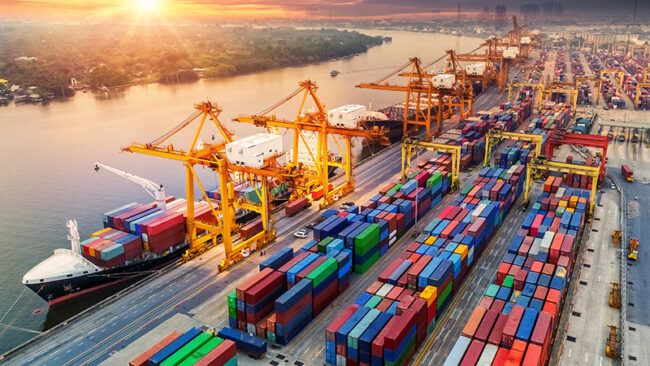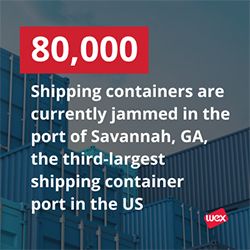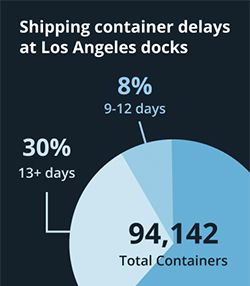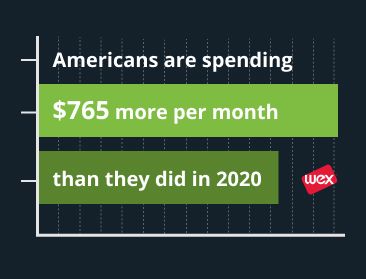Stay connected
Subscribe to our Inside WEX blog and follow us on social media for the insider view on everything WEX, from payments innovation to what it means to be a WEXer.
Save 25¢ per gallon for 3 months§ with the WEX Fleet Card. Hurry, offer ends TODAY. Learn more


The supply-chain crisis is a global disruption in the production and shipment of goods as a result of COVID-19. A concurrent boom in demand, a worker shortage, a dearth of necessary production equipment, and a lack of needed production space for the increase in demand have made the issue worse.
According to the New York Times, 80,000 containers are currently jammed in the port of Savannah, Georgia, the third-largest shipping container port in the US. This figure represents a 50% increase in capacity. Ports throughout Europe and Asia are facing similar traffic jams. In some places, including California, ports are beginning to charge onerous daily fees for containers left unclaimed.

The Daily Breeze is reporting that there are 94,142 containers sitting in Los Angeles Docks. “Almost 40% of those have been sitting there for more than nine days. About 8% have been sitting for 9 to 12 days. And 30% — or about 28,243 containers — have been there for at least 13 days.” With ports charging $100 per container per day, the costs quickly become untenable: the 30% of containers sitting in the port of Los Angeles unclaimed are costing affected companies more than $14 million a day.
In earlier stages of the COVID-19 pandemic, when vaccines were not yet available or even invented, finding that everyday items were missing from the shelves of the local grocer seemed an understandable consequence of the lockdown. As the vaccine became accessible in wealthier nations and the United States and much of the Global North began to re-open, noticeable shortages continued to crop up. These shortages were early indicators of a larger, looming crisis.
The chain of disruption began with the initial COVID outbreak in Wuhan, a manufacturing hub and the capital of the Hubei Province in China. Factory closures and production line stoppage followed — a catalyst for the global crisis to come. As Goodman puts it, “What once seemed like a temporary phenomenon — a traffic jam that would eventually dissipate — is increasingly viewed as a new reality that could require a substantial refashioning of the world’s shipping infrastructure.”

During lockdown, and the homebound existence that followed for many throughout the country, on average Americans were initially saving more and spending less. The budgeting required to buy a nice dinner out and a few tickets to the movies, or a weekend away, disappeared in the span of a few short days. As the pandemic dragged on, those who were fortunate to be gainfully employed and working from home started to find other ways to spend. As Jessica Dickler of CNBC reported, a recent survey shows that Americans are spending $765 more a month today than they did in 2020. With pent up funds and an unrealized desire to consume, spending has ballooned on things like home improvement projects, in-home exercise equipment and outdoor recreation gear. And now that many are venturing out more and even returning to the office, further avenues for spending have returned. With the subsequent increase in demand for products and supplies, increase in worker pay and increased employment opportunities (the US labor force is down by more than four million people), the crisis has not dissipated as anticipated.
These stoppages and hold-ups combined with an increase in a desire to consume are impacting the world’s supply chain in unprecedented ways which will have lasting implications for the way products and supplies are distributed and sold. There are multiple additional distribution factors contributing to the crisis including a shortage of cargo ships, a shortage of fleet drivers, and a decreased supply of shipping containers.
Fleet companies are facing difficulties maintaining enough drivers to keep up with the increase in shipping demands brought about by COVID. One factor playing a role in a paucity of drivers is the increased difficulty of the job. Because of the supply chain crisis drivers often face new barriers that make their work more challenging. As Jennifer Smith recently reported in the Wall Street Journal, “The surge of goods has created logjams at loading docks and port terminals, gobbling up scarce trucking capacity and making drivers’ jobs even harder. Factories and warehouses are also short of staff to load and receive goods. Meanwhile, the broader labor shortage has left openings for other blue-collar jobs that compete with trucking, including in local delivery operations, construction and manufacturing.” The American Trucking Association describes a shortage of as much as 80,000 fewer drivers than what’s currently needed and as we head into the holiday season, the problem will only be exacerbated.
Deloitte recently surveyed 96 CFOs at large North American firms, whose responses indicated that the supply chain crisis we are currently facing has resulted in dire consequences for many US businesses. Forty-four percent of CFOs said supply disruptions have increased costs by upwards of 5% this year, while 32% of respondents said that sales have fallen as a result of delays and/or shortages.
If fears of an increase beyond current inflation levels or even a recession resulting from the global supply chain crisis become a reality, it will be essential for fleet managers to find and deploy tools that create greater operational efficiency. As Fleet Owner recently reported, fleet companies are already feeling the impacts of supply chain issues, including experiencing a sharp increase in costs of common truck components such as tires and lubricants.
Using the tools that come with a fleet gas card is an easy and efficient way to prepare for what difficulties might lie ahead.
The addition of a fleet card to your business operations will provide you with tools to oversee your fleet, control costs, and run your business in the most efficient way possible. During leaner times, these benefits could be just the edge your business needs to stay viable and strong. Whether you have a small crew or are overseeing hundreds of vehicles, fleet cards help you save time and money by letting you:
Fleet fuel cards offer many tools beyond a way to pay for fuel. Below are seven ways a fleet card can provide your business with greater operational efficiency.
By using a fleet gas card, all of the fuel expense tracking and record-keeping is done automatically for your company. With a fleet card that offers you insights into card use, you’ll find that you no longer need to go through the arduous task of collecting receipts from your drivers. This can remove a time-consuming aspect of your workday and eliminate onerous daily tasks for you and your team. With a fleet card, the information tied to driver fuel purchases goes directly from the pump to a computer center for processing. Your company will have access to monthly vehicle analysis reports, detailing all purchases. You will see where all of your drivers used their fuel card, the time, the vehicle’s odometer reading, and what was purchased. This reporting also provides additional valuable information about driver activity, including cost per mile and miles per gallon.
Gone are the days when fleet drivers need to save receipts and fill out paperwork. With a fleet card, all of that paperwork and data collection is automatic, and automated expense tracking will save your operation time and money, not only at the pump, but down the line when automatic reporting will better ensure accuracy.
With many of the highest caliber fleet cards, you have the potential to take advantage of rebates and sales. Fleet cards often give fleet managers the opportunity to save on fuel expenses. Most fleet cards offer fuel rebates, so you can save a few cents per gallon at the issuing brand. (This means if you get a fleet card from Brand X, you get rebates on fuel purchased at Brand X locations.) The more you and your employees drive, the more savings add up, and will appear as a credit on your invoice.
The best fleet cards require drivers to enter identifying information for every purchase, like a PIN number and current odometer reading. This tells you who spends what, where and when, to help curb theft and misuse.
With access to this kind of fleet driver behavioral data fleet managers are provided in-depth budgeting insights to best allow for future planning.
With fintech payment solutions services such as these, your fleet card can also help you prevent fuel slippage (unauthorized use for items other than fuel) or fuel theft from occurring in your business. The security of knowing who spends what, identifying any potential employee theft, and having the ability to seamlessly cancel lost or stolen cards, will give you peace of mind as you manage your business going forward.
A good fleet card program also lets you control how employees can use the card. You will have the ability to limit purchases by product type, dollar amount, and even the time of day or day of the week a fleet card can be used.
The best fleet cards give you access to online reports you can download to your bookkeeping software. These reports should provide details like which driver is doing the purchasing, what fuel grade is being purchased, and what the sales tax is for every purchase. This transaction data translates seamlessly to actionable insights.
By choosing a provider that offers you additional tools to analyze fleet performance and fueling trends, you can strategize where the least expensive fuel can be purchased, and if you opt for GPS tracking (telematics) your fleet card can also help with providing your drivers with route optimization for every pick-up or delivery they make. Fuel card telematics are also powerful tools for optimizing vehicle performance which will lead to further cost savings and efficiencies.
When you and your drivers are on the road it’s useful to have access to online tools to manage your account, so be sure the fleet card company you partner with provides you and your fleet with mobile apps. Many fleet card companies offer a free mobile control center for your fuel card providing access to your account with just a single tap. These apps also allow you to view transactions, check your credit limit, cancel lost or stolen cards, and keep control of your business spend.
When shopping for the fleet fuel card that will provide you with the best opportunities to find efficiencies, consider looking for a universal fleet card. Universal fleet cards are accepted at any major US gas station, and tens of thousands of service locations. A universal fleet card will eliminate the need for your drivers to plan routes around where to fuel, and will keep them from having to drive miles out of the way to find the right station. Some fuel card providers also help your drivers find the least expensive fuel wherever their trip may take them.
Some fleet card companies offer additional savings networks which give you exclusive discounts on the things that keep a small business moving. These include discounts on:
Some companies provide their drivers with fleet cards that cover a variety of travel items beyond just gas. If you provide your drivers with a card that allows for service and maintenance purchases you’ll also be able to direct drivers to your company’s preferred service brands. A service transaction works a lot like a fuel transaction: your drivers can use the card for tires, parts, oil changes, and more. All purchases, including fuel purchases and service or maintenance purchases, will be included in detailed reports.
Running a business during a global supply chain crisis is a universal first, and every fleet manager is looking for ways to curb spending and find efficiencies to brace for what difficulties the future might bring. Working in a state of uncertainty as world leaders look to restore normalcy and move us beyond the COVID-19 pandemic and it’s accompanying economic crisis, we can be here for each other to get through this difficult time. One proven way for fleet managers to brace for times of economic downturn is by using a fleet card and all its accompanying tools. Fleet fuel cards offer simple, cost-effective ways to drive savings, all while simplifying and streamlining your work as a fleet manager.
All fleet cards are not the same, and different types of fuel cards suit the needs of different kinds and sizes of businesses. View WEX’s fleet card comparison chart to see which fleet fuel card is right for you.
To learn more about WEX, a growing and global organization, please visit wexinc.com.
Resources:
Bloomberg
New York Times
Los Angeles Times
Fleet Owner
Daily Breeze
Business Insider
CNBC
Wall Street Journal
Subscribe to our Inside WEX blog and follow us on social media for the insider view on everything WEX, from payments innovation to what it means to be a WEXer.